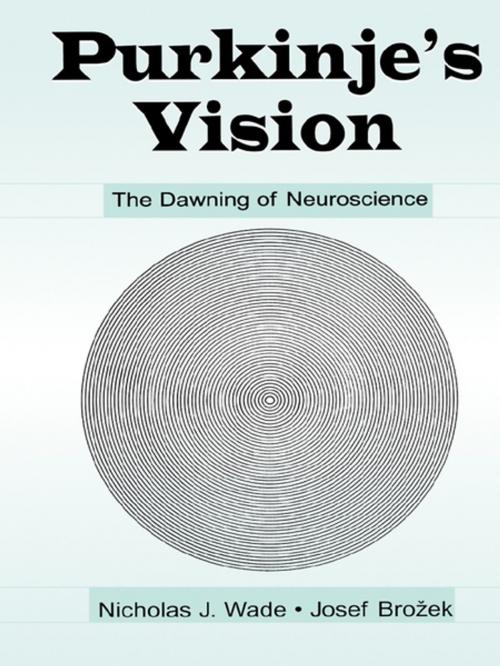Purkinje's Vision
The Dawning of Neuroscience
Nonfiction, Health & Well Being, Psychology, Cognitive Psychology| Author: | Nicholas J. Wade, Josef Brozek, Jir¡ Hoskovec | ISBN: | 9781135656409 |
| Publisher: | Taylor and Francis | Publication: | April 1, 2001 |
| Imprint: | Psychology Press | Language: | English |
| Author: | Nicholas J. Wade, Josef Brozek, Jir¡ Hoskovec |
| ISBN: | 9781135656409 |
| Publisher: | Taylor and Francis |
| Publication: | April 1, 2001 |
| Imprint: | Psychology Press |
| Language: | English |
The life of Jan Evangelista Purkinje (1787-1869) has fascinated students from many disciplines. Histologists marvel at his early descriptions of cells; physiologists admire his attempts to relate structure to function; pharmacologists view in awe his heroic experiments on self-administered drugs; forensic scientists acknowledge his role in the use of fingerprints for identification; and Czech patriots salute his awakening of pride in their nation. Yet all these achievements followed his initial enquiries into vision. It is this psychological dimension that fostered this collaboration.
As the title suggests, the present volume is bifocal. In the narrow sense it refers to Purkinje's studies of vision, but in its broader view it concerns Purkinje's anticipation of neuroscience. Purkinje provided evidence to support both its cellular and its conceptual base. At the cellular level his acute vision is immortalized within our bodies. At the conceptual level, he sought to relate subjective phenomena to their objective underpinnings--to link psychology to physiology.
Vision provides a bond that unites psychology and physiology, and it is this bond that was strengthened by Purkinje's enquiries. The authors have tried to provide a context in which Purkinje's descriptions of visual phenomena can be placed. In some cases this exposes clear precursors of research for which Purkinje has been credited. In others, there was nothing to suggest the phenomena that he exposed. The book translates Purkinje's initial masterpiece on subjective vision and places it in the context of emerging views of neuroscience.
The life of Jan Evangelista Purkinje (1787-1869) has fascinated students from many disciplines. Histologists marvel at his early descriptions of cells; physiologists admire his attempts to relate structure to function; pharmacologists view in awe his heroic experiments on self-administered drugs; forensic scientists acknowledge his role in the use of fingerprints for identification; and Czech patriots salute his awakening of pride in their nation. Yet all these achievements followed his initial enquiries into vision. It is this psychological dimension that fostered this collaboration.
As the title suggests, the present volume is bifocal. In the narrow sense it refers to Purkinje's studies of vision, but in its broader view it concerns Purkinje's anticipation of neuroscience. Purkinje provided evidence to support both its cellular and its conceptual base. At the cellular level his acute vision is immortalized within our bodies. At the conceptual level, he sought to relate subjective phenomena to their objective underpinnings--to link psychology to physiology.
Vision provides a bond that unites psychology and physiology, and it is this bond that was strengthened by Purkinje's enquiries. The authors have tried to provide a context in which Purkinje's descriptions of visual phenomena can be placed. In some cases this exposes clear precursors of research for which Purkinje has been credited. In others, there was nothing to suggest the phenomena that he exposed. The book translates Purkinje's initial masterpiece on subjective vision and places it in the context of emerging views of neuroscience.















